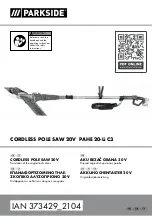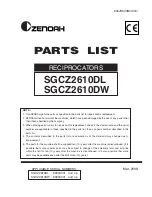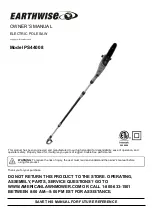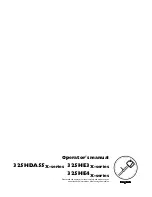
31
EN
before each use. Do not operate the saw if
the lower guard does not move freely and
close immediately. Never clamp or tie the
lower guard into the open position.
If saw is accidentally dropped, lower guard
may be bent. Raise the lower guard with
the retracting lever and make sure it moves
freely and does not touch the blade or any
other part, in all angles and depths of cut.
• Check the operation of the lower guard
spring. If the guard and the spring are not
operating properly, they must be serviced
before use.
Lower guard may operate
sluggishly due to damaged parts, gummy
deposits, or a build-up of debris.
• Lower guard may be retracted manually
only for special cuts such as "plunge cuts"
and "compound cuts". Raise lower guard
by retracting lever and as soon as blade
enters the material, the lower guard must
be released.
For all other sawing, the lower
guard should operate automatically.
• Always observe that the lower guard is
covering the blade before placing saw
down on bench or floor.
An unprotected,
coasting blade will cause the saw to walk
backwards, cutting whatever is in its path.
Be aware of the time it takes for the blade
to stop after switch is released.
Additional safety warnings for portable
circular saws
Warning of laser radiation Laser
class 2, P max.: < 1 mW,
λ
: 650
nm, EN 60825-1:2014
Do not look directly into the laser
beam or the opening from
which it emerges. Never point the laser beam
at people, animals or reflective surfaces. Even
brief eye contact can lead to eye damage.
Examining the laser output aperture by use
of optical instruments (e.g. magnifying glass,
magnifiers and the like) entails the risk of eye
damage. When working with a laser of class 2,
observe the national regulations on wearing
eye protection.
• Do not reach into the chip ejector with
your hands.
They could be injured by rotating parts.
• Do not work overhead with the saw.
In this manner you do not have sufficient
control over the power tool.
• Do not use abrasive wheels.
• Only use saw blades of a diameter
specified in the technical data
Using a
blade of the wrong size may leave the blade
without proper protection or affect the
functioning of the guard.
• Use suitable detectors to determine if
utility lines are hidden in the work area
or call the local utility company for
assistance.
Contact with electrical lines
may result in fire and electric shock.
Damaging a gas line may lead to an
explosion. Penetrating a water line causes
property damage and may cause an electric
shock.
• Do not operate the power tool stationary.
It is not designed for operation with a saw
table.
• Do not use high speed steel (HSS) saw
blades.
Such saw blades can easily break.
• Do not saw ferrous metals.
Red hot chips can ignite the dust extraction.
• Ensure a steady forward motion of the
tool.
An insufficient forward motion may
result in the overheating of the saw teeth
or the melting of the workpiece to be
processed.
Safety instructions for
charger
•
This charger can be used by
children aged from 8 years
and above and persons with
reduced physical, sensory
or mental capabilities or
lack of experience and
knowledge if they have
been given supervision
or instruction concerning
use of the charger in the
safe way and understand
















































